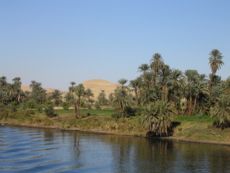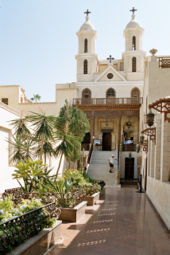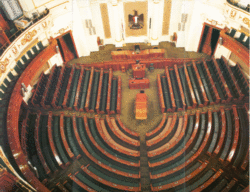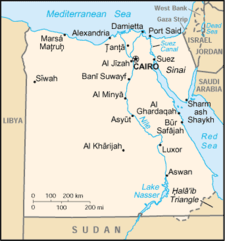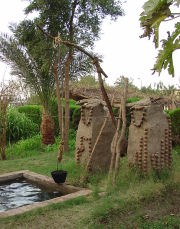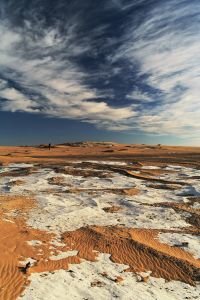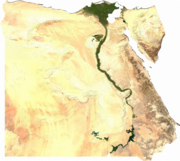Egypt
2007 Schools Wikipedia Selection. Related subjects: African Countries; Countries
| جمهورية مصر العربية Ǧumhūriyyat Miṣr al-ʿArabiyyah Arab Republic of Egypt |
|||||
|
|||||
| Anthem: Bilady, Bilady, Bilady | |||||
| Capital (and largest city) |
Cairo (Al-Qahirah) |
||||
| Official languages | Arabic, Masri (national) | ||||
|---|---|---|---|---|---|
| Government | Republic | ||||
| - President | Muhammad Hosni Mubarak | ||||
| - Prime Minister | Ahmed Nazif | ||||
| Establishment | |||||
| - First Dynasty | c.3150 BC | ||||
| - Independence granted | February 28, 1922 | ||||
| - Republic declared | June 18, 1953 | ||||
| Area | |||||
| - Total | 1,001,449 km² ( 30th) 386,660 sq mi |
||||
| - Water (%) | 0.6 | ||||
| Population | |||||
| - 2006 estimate | 78,887,007 ( 15th) | ||||
| - 1996 census | 59,312,914 | ||||
| - Density | 74/km² ( 120th) 192/sq mi |
||||
| GDP ( PPP) | 2004 estimate | ||||
| - Total | $305.253 billion ( 32nd) | ||||
| - Per capita | $4,317 ( 112th) | ||||
| HDI (2006) | 0.702 (medium) ( 111th) | ||||
| Currency | Egyptian pound (LE) ( EGP) |
||||
| Time zone | EET ( UTC+2) | ||||
| - Summer ( DST) | EEST ( UTC+3) | ||||
| Internet TLD | .eg | ||||
| Calling code | +20 | ||||
Egypt ( Egyptian: Km.t, Coptic: Ⲭⲏⲙⲓ Kīmi, Arabic: مصر Miṣr; Egyptian Arabic: Máṣr), officially the Arab Republic of Egypt, is a country in North Africa that includes the Sinai Peninsula, a land bridge to Asia. Covering an area of about 1,001,450 square kilometers (386,560 square miles), Egypt borders Libya to the west, Sudan to the south, and Israel and the Gaza Strip to the northeast; on the north and the east are the Mediterranean Sea and the Red Sea, respectively.
Egypt is the fifteenth most populous country in the world. The vast majority of its 78.8 million population (2006) live near the banks of the Nile River (about 40,000 km² or 15,450 sq miles) where the only arable agricultural land is found. Large areas of land form part of the Sahara Desert and are sparsely inhabited. Around half of Egypt's residents live in urban areas, with the majority spread across the densely populated centres of greater Cairo (the largest city in Africa and the Middle East), Alexandria and other major towns in the Nile Delta.
Egypt is famous for its ancient civilization and some of the world's most ancient and important monuments, including the Giza Pyramids and the Great Sphinx of Giza; the southern city of Luxor contains a particularly large number of ancient artifacts such as the Karnak Temple and the Valley of the Kings. Today, Egypt is widely regarded as the main political and cultural centre of the Middle East.
Etymology
| km.t (Egypt) in hieroglyphs |
||||
|
- One of the ancient Egyptian names of the country, km.t, or "black land," is derived from the fertile black soils deposited by the Nile floods, distinct from the 'red land' (dSr.t) of the desert. The name is realized as kīmi and kīmə in the Coptic stage of the Egyptian language, and appeared in early Greek as Kymeía.
- Miṣr, the Arabic and official name for modern Egypt ( Egyptian Arabic: Maṣr), is of Semitic origin directly cognate with the Hebrew מִצְרַיִם (Mitzráyim), meaning "the two straits" (a reference to the dynastic separation of upper and lower Egypt), and possibly means "a country" or "a state". Miṣr in Arabic also means "a country" or "a state".
- The English name "Egypt" came via the Latin word Aegyptus derived from the ancient Greek word Αίγυπτος (Aigyptos). According to Strabo, Αίγυπτος (Aigyptos), in ancient Greek meant "below the Aegean" (Aἰγαίου ὑπτίως, "Aegaeou uptiōs"), and was formed by the combination of the two words. It has also been suggested that the word is a corruption of the ancient Egyptian phrase ḥwt-k3-ptḥ meaning "home of the Ka (Soul) of Ptah", the name of a temple of the god Ptah at Memphis.
History
The Nile Valley was site of continuous human habitation since at least the Paleolithic. Traces of these early peoples appear in the form of artifacts and rock carvings along the terraces of the Nile and in the desert oases. In the 10th millennium BC, a grain- grinding culture using the earliest type of sickle blades had been replaced by another culture of hunter-gatherers and fishers using stone tools. Climate changes and/or overgrazing around 8000 BC began to desiccate the pastoral lands of Egypt, eventually forming the Sahara. Early tribal peoples migrated to the Nile River where they developed a settled agricultural economy and more centralized society.
By about 6000 BC, organized agriculture and large building construction had appeared in the Nile Valley. During the Neolithic, several predynastic cultures developed independently in Upper and Lower Egypt. The Badarian culture and the successor Naqada series are generally regarded as precursors to Dynastic Egyptian civilization. The earliest known Lower Egyptian site, Merimda, predates the Badarian by about seven hundred years. Contemporaneous Lower Egyptian communities coexisted with their southern counterparts for more than two thousand years, remaining somewhat culturally separate, but maintaining frequent contact through trade. The earliest known evidence of Egyptian hieroglyphic inscriptions appear during the predynastic period on Naqada III pottery vessels, dated to about 3200 BC.
| tAwy ('Two Lands') in hieroglyphs |
||
|
A unified kingdom was founded circa 3150 BC by King Menes, giving rise to a series of dynasties that ruled Egypt for the next three millennia. Egyptians subsequently referred to their unified country as tAwy, meaning 'Two Lands'; and later km.t ( Coptic: Kīmi), the 'Black Land', a reference to the fertile black soil deposited by the Nile river. Egyptian culture flourished during this long period and remained distinctively Egyptian in its religion, arts, language and customs. The first two ruling dynasties of a unified Egypt set the stage for the Old Kingdom period, c.2700−2200 BC., famous for its many pyramids, most notably the Third Dynasty pyramid of Djoser and the Fourth Dynasty Giza Pyramids.

The First Intermediate Period ushered in a time of political upheaval for about 150 years. Stronger Nile floods and stabilization of government, however, brought back renewed prosperity for the country in the Middle Kingdom c. 2040 BC, reaching a peak during the reign of Pharaoh Amenemhat III. A second period of disunity heralded the arrival of the first alien ruling dynasty in Egypt, that of the Semitic Hyksos. The Hyksos invaders took over much of Lower Egypt around 1650 BC, and founded a new capital at Avaris. They were eventually driven out by an Upper Egyptian force led by Ahmose I, who founded the Eighteenth Dynasty and relocated the capital from Memphis to Thebes.
The New Kingdom (c.1550−1070 BC) began with the Eighteenth Dynasty, marking the rise of Egypt as an international power that expanded during its greatest extension to an empire as far south as Jebel Barkal in Nubia, and included parts of the Levant in the east. This period is known for some of the most well-known Pharaohs, including Hatshepsut, Thutmose III, Akhenaten and his wife Nefertiti, Tutankhamun and Ramesses II. The first known self-conscious expression of monotheism came during this period in the form of Atenism. Frequent contacts with other nations brought in new ideas in the New Kingdom.
The Thirtieth Dynasty was the last native ruling dynasty during the Pharaonic epoch. It fell to the Persians in 343 BC after the last native pharaoh, King Nectanebo II, was defeated in battle. Later, Egypt fell to the Greeks and Romans, beginning over two thousand years of foreign rule. Before Egypt became part of the Byzantine realm, Christianity had been brought by Saint Mark the Evangelist in the AD first century. Diocletian's reign marks the transition from the Roman to the Byzantine era in Egypt, when a great number of Egyptian Christians were persecuted. The New Testament was by then translated into Egyptian, and after the Council of Chalcedon in AD 451, a distinct Egyptian Coptic Church was firmly established.
The Byzantines were able to regain control of the country after a brief Persian invasion early in the seventh century, until in AD 639, Egypt was invaded by the Muslim Arabs. The form of Islam the Arabs brought to Egypt was Sunni, though early in this period Egyptians began to blend their new faith with indigenous beliefs and practices that had survived through Coptic Christianity, giving rise to various Sufi orders that have flourished to this day. Muslim rulers nominated by the Islamic Caliphate remained in control of Egypt for the next six centuries, including a period for which it was the seat of the Caliphate under the Fatimids. With the end of the Ayyubid dynasty, a Turco- Circassian military caste, the Mamluks, took control about AD 1250 and continued to govern even after the conquest of Egypt by the Ottoman Turks in 1517.
The brief French Invasion of Egypt in 1801 had a great social impact on the country and its culture, as native Egyptians were introduced to the principals of the French Revolution and were invited to head their own government. A series of civil wars took place between the Ottoman Turks, the Mamluks, and Albanian mercenaries following the evacuation of French troops, resulting in the Albanian Muhammad Ali taking control of Egypt where he was appointed as the Ottoman viceroy in 1805. He led a modernization campaign of public works, including irrigation projects, agricultural reforms and increased industrialization, which were then taken up and further expanded by his grandson and successor Isma'il Pasha.
Following the completion of the Suez Canal by Ismail in 1869, Egypt became an important world transportation hub. In 1866, the Assembly of Delegates was founded to serve as an advisory body for the government. Its members were elected from across Egypt and eventually they came to have an important influence on governmental affairs. The country also fell heavily into debt to European powers. Ostensibly to protect its investments, the United Kingdom seized control of Egypt's government in 1882, but nominal allegiance to the Ottoman Empire continued until 1914 when as a result of the declaration of war with the Ottoman Empire, Britain declared a protectorate over Egypt and deposed the khedive, replacing him with his uncle who was appointed Sultan of Egypt.
Between 1882 and 1906, a local nationalist movement for independence was taking shape. The Dinshaway Incident prompted Egyptian opposition to take a stronger stand against British occupation and the first political parties were founded. After the first World War, Saad Zaghlul and the Wafd Party led the Egyptian nationalist movement after gaining a majority at the local Legislative Assembly. When the British exiled Zaghlul and his associates to Malta on March 8, 1919, Egypt witnessed its first modern revolution. Constant revolting by the Egyptian people throughout the country led Great Britain to issue a unilateral declaration of Egypt's independence on February 22, 1922.
The new Egyptian government drafted and implemented a new constitution in 1923 based on a parliamentary representative system. Saad Zaghlul was popularly-elected as Prime Minister of Egypt in 1924, and in 1936 the Anglo-Egyptian Treaty was concluded. However, continued instability in the government due to remaining British control and increasing involvement by the King in politics led to the eventual toppling of the monarchy and the dissolution of the parliament through a coup d'état by a group of army officers in 1952. They forced King Farouk I to abdicate in support of his son King Ahmed Fouad II.

The Egyptian Republic was declared on 18 June 1953 with General Muhammad Naguib as the first President of the Republic. Naguib was forced to resign in 1954 by Gamal Abdel Nasser – the real architect of the 1952 movement – and was later put under house arrest. Nasser assumed power as President and declared the full independence of Egypt from the United Kingdom on June 18, 1956. His nationalization of the Suez Canal on July 26, 1956 prompted the 1956 Suez Crisis. Three years after the 1967 Six Day War, in which Egypt lost the Sinai to Israel, Nasser died and was succeeded by Anwar Sadat. Sadat switched Egypt's Cold War allegiance from the Soviet Union to the United States, expelling Soviet advisors in 1972, and launched the Infitah economic reform policy, while violently clamping down on religious and secular opposition alike.
In 1973, Egypt, along with Syria, launched a surprise attack on Israel in an attempt to regain the occupied Sinai Penninsula. Both the US and the USSR intervened and a cease-fire was reached between both sides. Despite not being a complete military success, most historians agree that the Yom Kippur war presented Sadat with a political victory that would later allow him to pursue peace with Israel. In 1977, Sadat made a historical visit to Israel which led to the 1978 peace treaty in exchange for the complete Israeli withdrawal from Sinai. Sadat's initiative sparked enormous controversy in the Arab world and led to Egypt's expulsion from the Arab League, but was supported by the vast majority of Egyptians. Sadat was assassinated in Cairo by a fundamentalist military soldier in 1981 and was succeeded by the incumbent Hosni Mubarak. In 2003, the Egyptian Movement for Change, popularly known as Kifaya, was launched to seek a return to democracy and greater civil liberties.
Politics
National
Egypt has been a republic since 18 June 1953. President Mohamed Hosni Mubarak has been the President of the Republic since October 14, 1981, following the assassination of former-President Mohammed Anwar El-Sadat. Mubarak is currently serving his fifth term in office. He is the leader of the ruling National Democratic Party. Prime Minister Dr. Ahmed Nazif was sworn in as Prime Minister on 9 July 2004, following the resignation of Dr. Atef Ebeid from his office.
Although power is ostensibly organized under a multi-party semi-presidential system, whereby the executive power is theoretically divided between the President and the Prime Minister, in practice it rests almost solely with the President who traditionally has been elected in single-candidate elections for more than fifty years. Egypt also holds regular multi-party parliamentary elections. The last presidential election, in which Mubarak won a fifth consecutive term, was held in September 2005.
In late February 2005, President Mubarak announced in a surprise television broadcast that he had ordered the reform of the country's presidential election law, paving the way for multi-candidate polls in the upcoming presidential election. For the first time since the 1952 movement, the Egyptian people had an apparent chance to elect a leader from a list of various candidates. The President said his initiative came "out of my full conviction of the need to consolidate efforts for more freedom and democracy." However, the new law placed draconian restrictions on the filing for presidential candidacies, designed to prevent well-known candidates such as Ayman Nour from standing against Mubarak, and paved the road for his easy re-election victory.
Concerns were once again expressed after the 2005 presidential elections about government interference in the election process through fraud and vote-rigging, in addition to police brutality and violence by pro-Mubarak supporters against opposition demonstrators. This poses major questions about the government's purported commitment to democracy.
As a result, most Egyptians are skeptical about the process of democratization and the role of the elections. Less than 25 percent of the country's 32 million registered voters (out of a population of more than 78 million) actually turned out for the 2005 elections. Newspapers, however, have exhibited an increasing degree of freedom in criticizing the president, and the results of the 2005 parliamentary elections, which saw Islamist candidates such as the banned Muslim Brotherhood winning seats, indicate that a change of some sorts may be underway.
International
The permanent headquarters for the League of Arab States (The Arab League) is located in Cairo. The Secretary General of the League has traditionally been an Egyptian. Former Egyptian Foreign Minister Amr Moussa is the current Secretary General of the Arab League. The Arab League briefly moved out of Egypt to Tunis in 1978 as a protest at the peace treaty with Israel, but returned in 1989.
Egypt was the first Arab state to establish diplomatic relations with the state of Israel, after the signing of the Egypt-Israel Peace Treaty at the Camp David Accords. Egypt has a major influence amongst other Arab states, and has historically played an important role as a mediator in resolving disputes between various Arab nations, and in the Israeli-Palestinian dispute. Most Arab nations still give credence to Egypt playing that role, though its effects are often limited.
Former Egyptian Deputy Prime Minister Boutros Boutros-Ghali served as Secretary General of the United Nations from 1991 to 1996.
A territorial dispute with Sudan over an area known as the Hala'ib Triangle, has meant that diplomatic relations between the two remain strained.
Human rights
Several local and international human rights organizations, including Amnesty International and Human Rights Watch, have reported on Egypt's poor human rights record for many years. In 2005, the government of Egypt faced unprecedented public criticism as Egyptian democracy activists challenged President Hosni Mubarak's quarter century of authoritarian rule. Some of the numerous and most serious violations include routine torture; arbitrary detentions and trials before military and state security courts; discriminatory personal status laws governing marriage, divorce, custody and inheritance with respect to women; and discriminatory laws against religious minorities–particularly Christians and Bahá'ís–which place severe restriction on church building and renovation among other violations.
Approximately fifteen thousand people remain in prolonged detention without charge under the Emergency Law, according to the Cairo-based Human Rights Association for Assistance to Prisoners. The Egyptian government last renewed the Emergency Law (Law No. 162 of 1958) in May 2006 for another term.
The Egyptian Organization for Human Rights (EOHR) is one of the longest-standing bodies for the defense of human rights in Egypt.
Military
The Egyptian military is one of the largest and strongest military powers on the African continent and the Middle East. The Egyptian Armed forces have also had more battle-field experience than most armies in the region, with a combined troop strength of around 450,000 active personnel.
Conscription is compulsory for Egyptian men of 18 years of age who are not the only male child. Full-time students may defer their service until the age of 28. The length of the service depends on the level and kind of education achieved by the conscript and needs of the army at the time of conscription.
Egypt continues to contribute regularly to United Nations peacekeeping missions, most recently in East Timor, Sierra Leone, and Liberia.
Administrative divisions
Egypt is divided into twenty-seven governorates (muhafazat, singular muhafazah).
|
|
Economy
Egypt's economy depends mainly on agriculture, media, petroleum exports, and tourism; there are also more than five million Egyptians working abroad, mainly in Saudi Arabia, the Persian Gulf and Europe. The United States as well has a large population of Egyptian immigrants.
The completion of the Aswan High Dam in 1971 and the resultant Lake Nasser have altered the time-honored place of the Nile River in the agriculture and ecology of Egypt. A rapidly-growing population (the largest in the Arab world), limited arable land, and dependence on the Nile all continue to overtax resources and stress the economy.
The government has struggled to prepare the economy for the new millennium through economic reform and massive investments in communications and physical infrastructure. Egypt has been receiving U.S. foreign aid (since 1979, an average of $2.2 billion per year) and is the third-largest recipient of such funds from the United States following the Iraq war. Its main revenues however come from tourism as well as traffic that goes through the Suez Canal.
Economic conditions are starting to improve considerably after a period of stagnation from the adoption of more liberal economic policies by the government, as well as increased revenues from tourism and a booming stock market. In its annual report, the IMF has rated Egypt as one of the top countries in the world undertaking economic reforms.
Demographics
Egypt is the most populous country in the Middle East and the second-most populous on the African continent, with nearly 79 million people. Almost all the population is concentrated along the banks of the Nile (notably Alexandria and Cairo), in the Delta and near the Suez Canal. Approximately 90% of the population adheres to Islam and most of the remainder to Christianity (primarily the Coptic Orthodox denomination). Apart from religious affiliation, Egyptians can be divided demographically into those who live in the major urban centers and the fellahin or farmers of rural villages.
Egyptians are by the far the largest ethnic group in Egypt at 97-98% (about 76.4 million) of the total population. Ethnic minorities include the Bedouin Arab tribes living in the eastern deserts and the Sinai Peninsula, the Berber-speaking Siwis of the Siwa Oasis, and the ancient Nubian communities clustered along the Nile in the southernmost part of Egypt. Egypt also hosts some 90,000 refugees and asylum seekers, made up mostly of 70,000 Palestinian refugees and 20,000 Sudanese refugees. The once-vibrant Jewish community in Egypt has virtually disappeared, with only a small number remaining in Egypt and those who visit on religious occasions. Several important Jewish archaeological and historical sites remain.
Religion
Religion plays a central role in most Egyptians' lives as visitors to the country quickly discover. The rolling calls to prayer that are heard five times a day have the informal effect of regulating the pace of everything from business to entertainment. Cairo is famous for its numerous mosque minarets and church towers.
Egypt is predominantly Muslim, at approximately 90% of the population, with the majority being adherents of the Sunni branch of Islam. A significant number of Muslim Egyptians also follow native Sufi orders. Christians represent about 10% of the population, with the largest being the Coptic denomination (primarily Coptic Orthodox, but also Coptic Catholic and Coptic Protestant) at 9%, while the remaining 1% include Roman Catholics, Greek Orthodox, Syriac Orthodox, and Armenian Orthodox, largely found in Alexandria and Cairo.
According to the constitution, any new legislation must implicitly agree with Islamic laws. The mainstream Hanafi school of Sunni Islam is largely organised by the state, through Wizaret Al-Awkaf (Ministry of Religious Affairs). Al-Awkaf controls all mosques and overviews Muslim clerics. Imams are trained in Imam vocational schools and at Al-Azhar University. The department supports Sunni Islam and has commissions authorised to give Fatwa judgements on Islamic issues.
Egypt hosts two major religious institutions. Al-Azhar University (Arabic: جامعة الأزهر) is the oldest Islamic institution of higher studies (founded around 970 A.D) and considered by many to be the oldest extant university. Egypt also has a strong Christian heritage as evidenced by the existence of the Coptic Orthodox Church headed by the Patriarch of Alexandria, which has a following of approximately 50 million Christians worldwide, most importantly in Ethiopia and Eritrea (one of the famous Coptic Orthodox Churches is Saint Takla Haimanot Church in Alexandria).
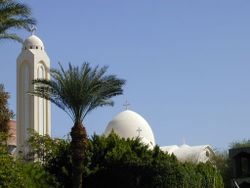
Religious freedom for Egypt's Coptic Christian community is hampered to varying degrees by extremist Islamist groups and by discriminatory and restrictive government policies. Until recently, Christians were required to obtain presidential approval for even minor repairs in churches, but the law was recently eased. Copts have faced increased marginalization after the 1952 coup d'état. That however changed to some degree when President Sadat appointed Boutros Boutros-Ghali, as the Egyptian Foreign Minister. Prominent Copts on the cabinet now include Finance Minister Youssef Boutros Ghali and Environment Minister Maged George. In addition, Naguib Sawiris, an extremely successful businessman and one of the wealthiest people internationally is an Egyptian Copt. Under the Mubarak government, Coptic Christmas (January 7) was recognized as an official holiday in 2002. The Coptic community however has occassionally been the target of hate crimes and physical assault, most recently during attacks on three churches in Alexandria. In addition, many Copts continue to complain of being minimally represented in law enforcement, state security and public office, and of being discriminated against in the workforce on the basis of their religion.
Egypt was once home to one of the oldest Jewish communities in the world. Jews partook of all aspects of Egypt's social and political life; one of the most ardent Egyptian nationalists, Yaqub Sanu' (Abu Naddara), was a Jew, as was popular singer Leila Mourad. After the 1956 Suez Crisis, some 25,000 Egyptian Jews were expelled by Gamal Abdel Nasser, their Egyptian citizenship was revoked and their property was confiscated. A steady stream of migration of Egyptian Jews followed, reaching a peak after the Six-Day War with Israel in 1967. Today, Jews in Egypt number less than 200.
Bahá'ís in Egypt, whose population ranges between several hundred and a few thousand, have their institutions and community activities banned. Since their faith is not officially recognized by the state, they are also not allowed to use it on their national identity cards (conversely, Islam, Christianity, & Judaism are officially recognized); hence most of them do not hold national identity cards. In April 2006 a court case recognized the Bahá'í Faith, but the government appealed the court decision and succeeded in having it suspended on 15 May.
There are Egyptians who identify as atheist and agnostic, but their numbers are largely unknown as openly advocating such positions risks legal sanction. In 2000, an openly atheist Egyptian writer, who called for the establishment of a local association for atheists, was tried on charges of insulting Islam in four of his books.
Geography
At 386,636 mi² (1,001,450 km² ), Egypt is the world's thirtieth-largest country (after Mauritania). It is comparable in size to Tanzania, and is more than half the size of the US state of Alaska.
Egypt is bordered by Libya on the west, Sudan on the south, and on Israel and Gaza Strip on the northeast. Egypt's important role in geopolitics stems from its strategic position: a transcontinental nation, it possesses a land bridge (the Isthmus of Suez) between Africa and Asia, which in turn is traversed by a navigable waterway (the Suez Canal) that connects the Mediterranean Sea with the Indian Ocean via the Red Sea.
Apart from the Nile Valley, the majority of Egypt's landscape is a big, sandy desert. The winds blowing can create sand dunes over one hundred feet high. Egypt includes parts of the Sahara Desert and of the Libyan Desert. These deserts were referred to as the "red land" in ancient Egypt, and they protected the Kingdom of the Pharaohs from western threats.
Towns and cities include Alexandria, one of the greatest ancient cities, Aswan, Asyut, Cairo, the modern Egyptian capital, El-Mahalla El-Kubra, Giza, the site of the Pyramid of Khufu, Hurghada, Luxor, Kom Ombo, Port Safaga, Port Said, Sharm el Sheikh, Suez, where the Suez Canal is located, Zagazig, and Al-Minya. Oases include Bahariya, el Dakhla, Farafra, el Kharga and Siwa.
Protectorates include Ras Mohamed National Park, Zaranik Protectorate and Siwa. See Egyptian Protectorates for more information.
Climate
Egypt has a dry climate. It is hot in the summer, with temperatures averaging between 80 and 90°F. Winters are warm, with temperatures averaging between 55 and 70°F. A steady wind from the northwest helps hold down the temperature near the coast. The Khamaseen is a wind that blows from the south in Egypt, usually in spring or summer, bringing sand and dust, and sometimes raises the temperature in the desert to more than 100°F. Rain seldom falls in Egypt. Along the Mediterranean Coast, the average yearly rainfall is 8 inches. Farther south, only about one inch of rain falls every year.
Culture
Egyptian culture has five thousand years of recorded history. Ancient Egypt was among the earliest civilizations and for millennia, Egypt maintained a strikingly complex and stable culture that influenced later cultures of Europe, the Middle East and Africa. After the Pharaonic era, Egypt itself came under the influence of Hellenism, Christianity, and Islamic culture. Today, many aspects of Egypt's ancient culture exist in interaction with newer elements, including the influence of modern Western culture, itself with roots in ancient Egypt.
Egypt's capital city, Cairo, is Africa's largest city and has been renowned for centuries as a centre of learning, culture and commerce. Egypt has the highest number of Nobel Laureates in Africa and the Arab World. Some Egyptian born politicians were or are currently at the helm of major international organizations like Boutros Boutros-Ghali of the United Nations and Mohamed ElBaradei of the IAEA.
Renaissance
In the mid-nineteenth century, Rifa'a et-Tahtawi started the Egyptian Renaissance, which renewed interest in Egyptian antiquity and exposed Egypt to Enlightenment principals. Tahtawi co-founded with education reformer Ali Mubarak a native Egyptology school that looked for inspiration to medieval Egyptian scholars, such as Suyuti and Maqrizi, who themselves studied the history, language and antiquities of Egypt. Egypt's renaissance reached a peak through the work of people like Muhammad Abduh, Ahmed Lutfi el-Sayed, Qasim Amin, Salama Moussa and Taha Hussein. They forged a liberal path for Egypt expressed as a commitment to individual freedom, secularism and faith in science to bring progress.
Arts
The Egyptians were one of the first major civilizations to codify design elements in art. The wall paintings done in the service of the Pharaohs followed a rigid code of visual rules and meanings. Modern and contemporary Egyptian art can be as diverse as any works in the world art scene. The Cairo Opera House serves as the main performing arts venue in the Egyptian capital. Egypt's media and arts industry has flourished since the late nineteenth century, today with more than thirty satellite channels and over one hundred motion pictures produced each year. Cairo in fact has long been known as the "Hollywood of the Middle East." To bolster its media industry further, especially with the keen competition from the Persian Gulf Arab States and Lebanon, a large media city was built. Some Egyptian actors, like Omar Sharif, have achieved world-wide fame.
Literature
Literature constitutes an important cultural element in the life of Egypt. Egyptian novelists and poets were among the first to experiment with modern styles of Arabic literature, and the forms they developed have been widely imitated throughout the Middle East. The first modern Egyptian novel Zaynab by Muhammad Husayn Haykal was published in 1913 in the Egyptian vernacular. Egyptian novelist Naguib Mahfouz was the first Arabic-language writer to win the Nobel Prize in Literature. Egyptian women writers include Nawal El Saadawi, well known for her feminist activism, and Alifa Rifaat who also writes about women and tradition. Vernacular poetry is perhaps the most popular literary genre amongst Egyptians, represented by such luminaries as Ahmed Fuad Nigm (Fagumi), Salah Jaheen and Abdel Rahman el-Abnudi.
Music
Egyptian music is a rich mixture of indigenous, Mediterranean, African and Western elements. In antiquity, Egyptians were playing harps and flutes, including two indigenous instruments: the ney and the oud. Percussion and vocal music also became an important part of the local music tradition ever since. Contemporary Egyptian music traces its beginnings to the creative work of people such as Abdu-l Hamuli, Almaz and Mahmud Osman, who influenced the later work of Egyptian music giants such as Sayed Darwish, Umm Kulthum, Mohammed Abdel Wahab and Abdel Halim Hafez. From the 1970s onwards, Egyptian pop music has become increasingly important in Egyptian culture, while Egyptian folk music continues to be played during weddings and other festivities.
Festivals
Egypt is famous for its many festivals and religious carnivals, also known as mulids. They are usually associated with a particular Coptic or Sufi saint, but are often celebrated by all Egyptians irrespective of creed or religion. Ramadan has a special flavor in Egypt, celebrated with sounds, lights (local lanterns known as fawanees) and much flare that many Muslim tourists from the region flock to Egypt during Ramadan to witness the spectacle. The ancient spring festival of Sham en Nisim ( Copto- Egyptian: Ϭⲱⲙ‘ⲛⲛⲓⲥⲓⲙ shom en nisim) has been celebrated by Egyptians for thousands of years, typically between the Egyptian months of Baramouda (April) and Bashans (May) following Easter Sunday.
Sports
Football (soccer) is the de facto national sport of Egypt. Egyptian Soccer clubs El Ahly and El Zamalek are the two most popular teams and enjoy the reputation of long-time champions of the sport regionally. Squash and tennis are other close favorites among Egyptians. The Egyptian Squash team has been known for its fierce competition in world-wide championships since 1930s.
Geographic locale
 |
Mediterranean Sea |
Mediterranean Sea |
 |
|
| Red Sea |
||||



![I6 [km] km](../../images/249/24947.png)
![G17 [m] m](../../images/249/24948.png)
![X1 [t] t](../../images/82/8241.png)
![O49 [niwt] niwt](../../images/249/24949.png)
